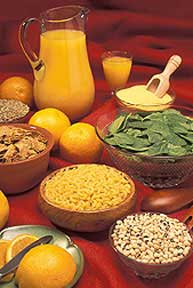IGEM:Caltech/2008
|
We aim to engineer a probiotic bacterium to improve its medical applications. Our work focuses on four main areas: (1) pathogen defense, either by expression of pathogen-specific bacteriophage or by targeted bursts of reactive oxygen species; (2) vitamin over-expression and delivery; (3) treatment of lactose intolerance, by preferentially metabolizing lactose and funneling it to vitamin production; and (4) regulation of these three treatment functions to produce subpopulations specialized for each function.
Vitamin Production Folate is the generic term for the various forms of Vitamin B9, which include dihydrofolate (DHF), tetrahydrofolate (THF), and folic acid. An essential vitamin for cell survival, folate is involved in amino synthesis (and thus DNA synthesis) as well as single-carbon-transfer reactions. Though humans don't produce folate, folate deficiency can cause serious birth defects and anemia. As a result, most cereals and breads are supplemented with folate. Folate has also been shown to have good bioavailability in the large intestine, and so is more easily absorbed by the host than other vitamins. Our aim is to engineer a strain of E. coli that will overexpress folate such that a person without access to green, leafy vegetables or folate-supplemented foods can still obtain the necessary daily amount by having this strain residing in their gut. Lactose intoleranceLactose intolerance is the inability to metabolize lactose in the small intestine. For a non lactose intolerant person, he or she is able to express β-galactosidase in the small intestine which cleaves lactose into glucose and galactose. Glucose and galactose are then taken up by the host. For a lactose intolerant person, lactose travels passed the small intestine into the large intestine where it is metabolized by the gut flora. The osmolarity changes in the large intestine due to the large amounts of sugar, pulling more water into the large intestine. Due to this rush of water, lactose intolerant persons may experience diarrhea. Lactose is metabolized in this order: Lactose --> glucose + galactose --> lactic acid + acetic acid --> H2 --> methane. A different bacteria is involved in each step, so we can't engineer our strain to metabolize lactose, because it will eventually get metabolized into methane, which is the cause of abdominal pain and unwanted gas. Instead, we will engineer a strain of E. coli that will express the β-Gal gene in the large intestine to quickly cleave lactose. The host will then be able to reabsorb the glucose and galactose from the large intestine. Population Variation |
